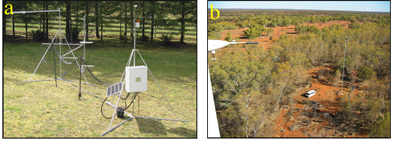SURFACE
ENERGY FLUX MEASUREMENTS
This
investigative team has deployed a Radiation and Energy Balance Systems,
Inc (REBS) Bowen Ratio system (Figure 1a) in August, 2003, on the western
side of the bunny fence at one of the agricultural
research stations in the Merredin Dryland Research Institute The
REBS Bowen ratio system determines the surface energy balance components
using the Bowen Ratio Energy Balance Method. This system
calculates the available energy at the surface, which is the sum
of net radiation and soil heat flow, and separates it into latent
heat and sensible heat fluxes. The Bowen ration is a ratio
of sensible heat flux to latent heat flux, and this ratio is computed
from measured near surface gradients of temperature and humidity
and using transport equations for heat and moisture. The
REBS Bowen ratio system uses a double-sided total hemispherical
radiometer and a double-sided pyranometer to measure upwelling
and downwelling longwave and shortwave fluxes at the surface. A
soil sensor cluster in this system measures soil moisture, soil
temperature and ground heat flux. Temperature and humidity
sensors measure vertical temperature and vapor pressure gradients
needed for determining the Bowen Ratio. A unique feature
of this system is the automatic exchange of humidity and temperature
sensor location every fifteen minutes. This feature is essential
for accurate measurements of surface energy fluxes when using a
Bowen ratio system. The system also has a tipping bucket
rain gauge for measuring rainfall, as well as a barometer and an
anemometer. The system is powered using a deep cycle marine
battery that is charged by a solar panel during the daytime. The
data collected by the system is logged using in a Campbell Scientific
CR10X datalogger. This system, which is valued at $22,000, will
be made available to this project for the minimal cost of shipping
it to Australia and associated personnel travel funds. Funds
for shipping and travel are requested since the current deployment
of the system in Australia is expected to last only for a period
of six month after which it will be used elsewhere.
A 25m flux tower for studying carbon fluxes, has been erected on
the eastern side of the bunny fence in the native vegetation area
at Sturt Meadows by a Japanese research team led by Prof. Koichi
Yamada. This system also provides similar measurements of
energy fluxes, soil moisture and other precipitation (Figure 1b). This
flux tower is expected to be operational during the proposed period
of the study and Prof. Yamada has agreed to provide the data
from this tower for the proposed study.
 |
Figure
1. Instrumentation for measuring surface energy budget
and soil moisture. a) The REBS Bowen Ratio
Station ; b) the 25 m flux tower at Sturt
Meadows, southwest Australia |
Using the data acquired from these two surface energy flux measurement
sites, along with radiosonde, aircraft and satellite observations,
the investigative team will assess the role of land use in boundary
layer development and cloud formation. The surface energy
fluxes will also be used along with perturbation analysis of radiosonde
wind observations to aid in the identification of mesoscale circulation
patterns. The intensity of mesoscale circulations is expected
to be proportional to differences in surface energy fluxes between
native areas of contrasting land use and atmospheric stability. Correlations
between patterns observed in the perturbation wind analysis and
surface energy fluxes thus aid in identifying the mesoscale circulations
using radiosonde observations. The surface energy flux measurements
will also be used for verifying the performance of numerical model
simulations.
<--top |

